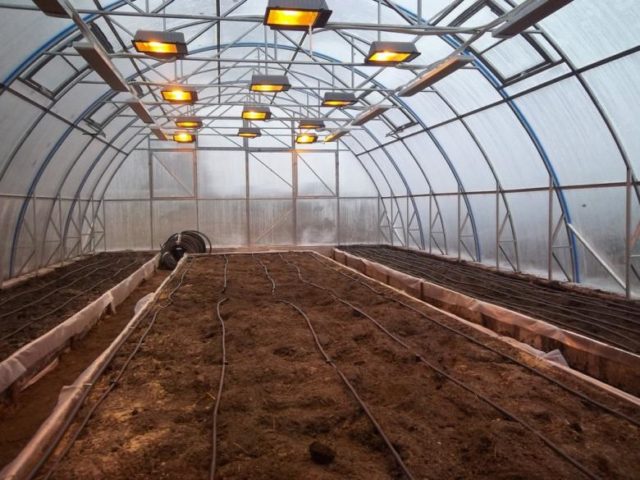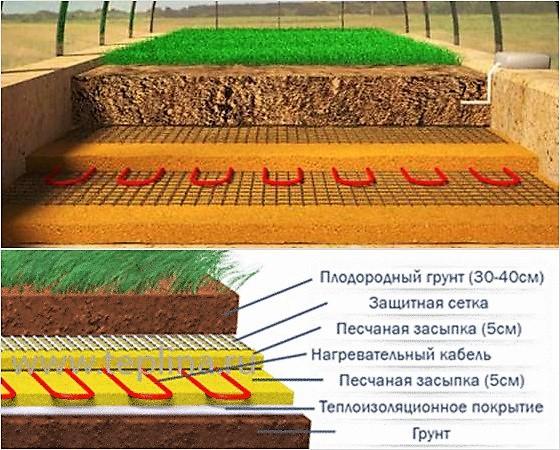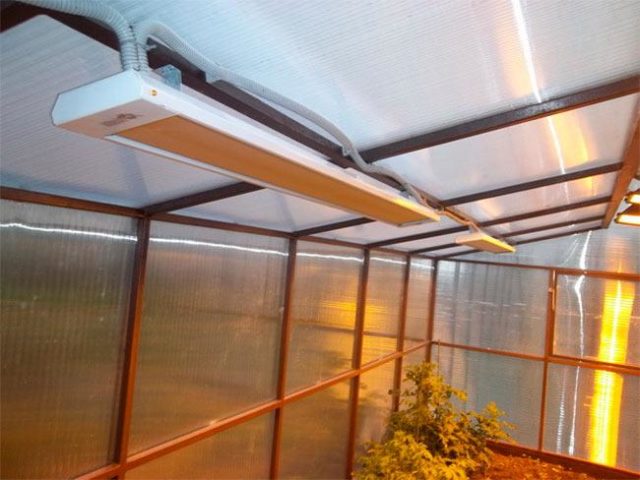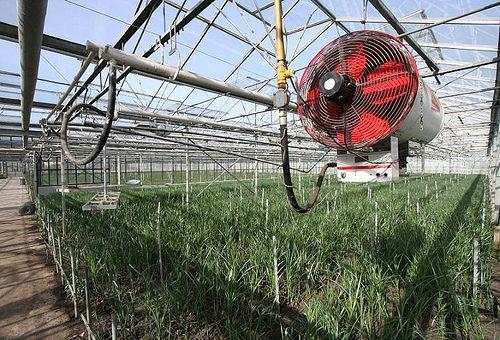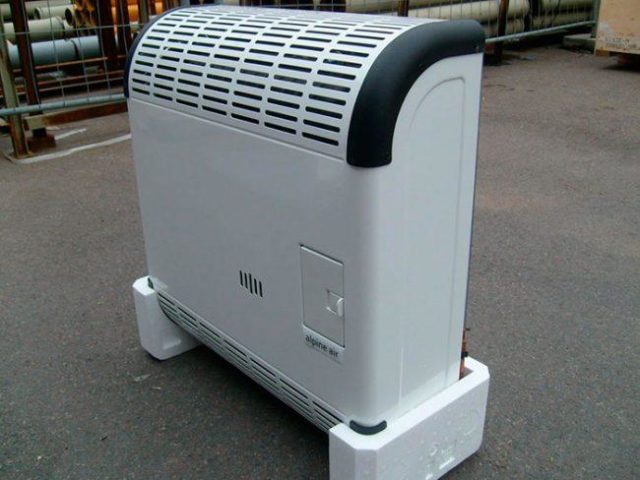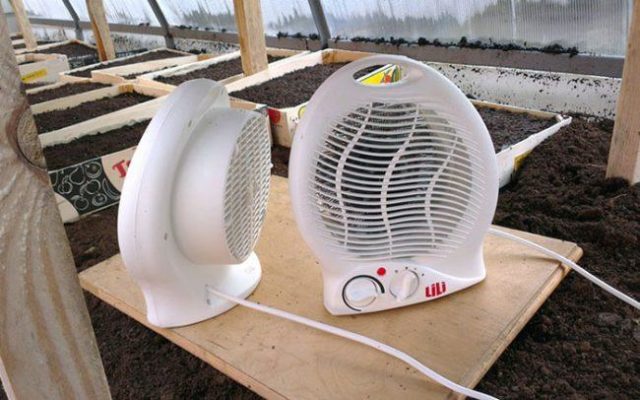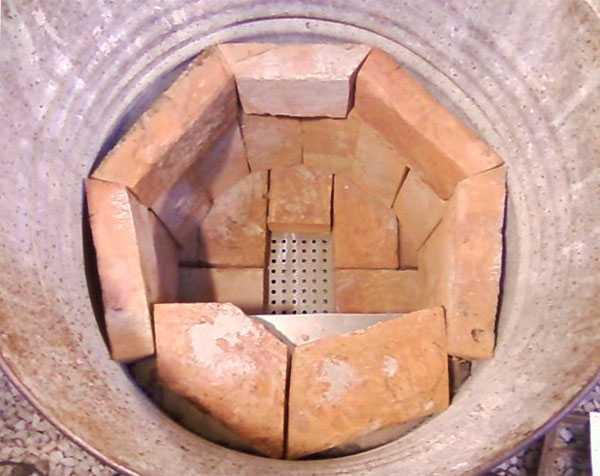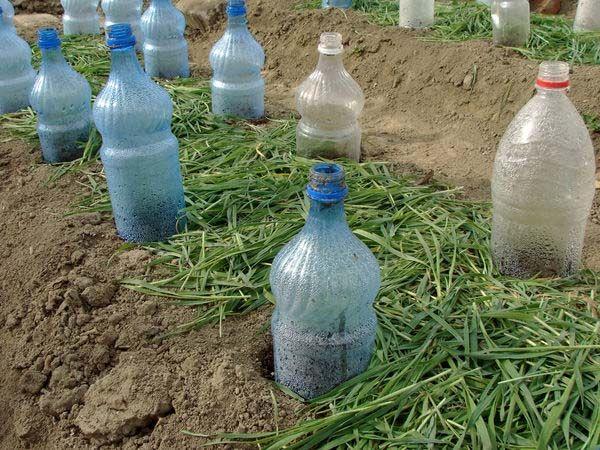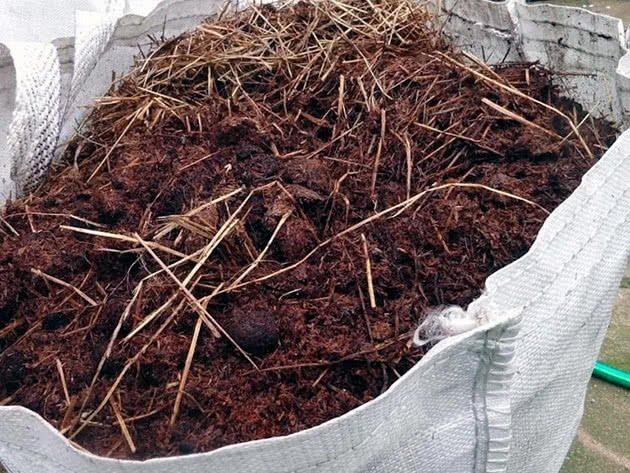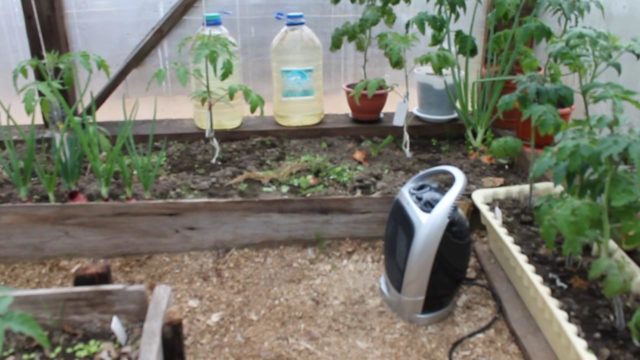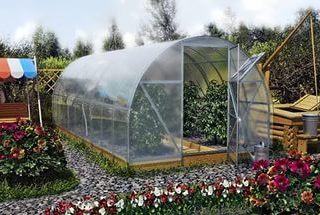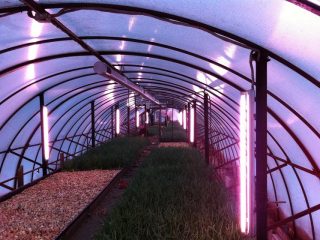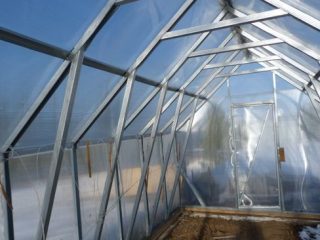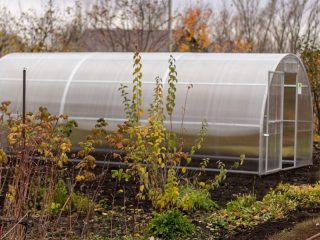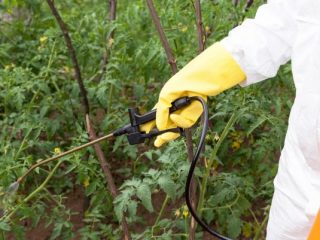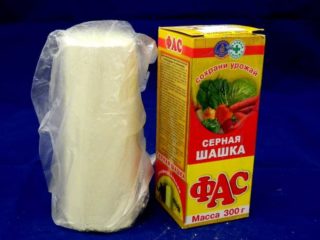Content
- 1 How can you heat a polycarbonate greenhouse in early spring
- 2 Heating the ground in the greenhouse with a heating cable
- 3 Heating the greenhouse with pipes underground
- 4 How to warm up the ground in a greenhouse in the spring with an infrared heater
- 5 How to heat a greenhouse in early spring with warm air
- 6 Heating a polycarbonate greenhouse with a gas heater
- 7 How else can you heat the greenhouse in spring
- 8 Conclusion
Polycarbonate greenhouses have become very popular among summer residents and owners of country houses. Polycarbonate is notable for its inexpensive cost, high level of thermal insulation, resistance to various weather conditions, shock resistance and immunity to ultraviolet radiation. These greenhouses can be used all year round or only for one season, for example in the spring. The best do-it-yourself greenhouse heating projects will help protect the crop from spring frosts.
How can you heat a polycarbonate greenhouse in early spring
There are many ways to heat a greenhouse in spring. They differ in complexity, efficiency, and cost, and are categorized as major and minor. The main heating methods include:
- Solar... Does not require additional costs and is based on the greenhouse effect. This method is effective only during the period of solar activity. Polycarbonate is able to trap light, thus increasing the temperature inside the greenhouse. But in the event of frost, the soil and plant roots will be unprotected.
- Biological... It consists in heating the soil by adding biofuel. Most often, gardeners use bird and animal manure mixed with peat, straw, sawdust or bark. You can use a solution made from slaked lime, straw and superphosphate. This method is rather laborious and does not allow timely control of the soil temperature.
- Technical... It involves the use of various electrical heating devices and devices - electric heaters, heat guns, radiators. When operating the greenhouse only in the springtime, the installation of expensive and complex heating devices is not required.
These and other methods allow you to heat the greenhouse in spring with your own hands. They have both their advantages and disadvantages, which must be taken into account in order to make the right decision in choosing a specific type of heating for a polycarbonate greenhouse.
Heating the ground in the greenhouse with a heating cable
The use of a heating cable is a relatively new way of heating greenhouses in spring and works on the principle of "warm floor". A heating cable has one or more heating elements that generate heat when an electric current flows through them.
The advantages of the method of heating the ground in a greenhouse with a cable include:
- safety - they are protected from overheating even when foliage, earth and debris get on them;
- Ease of controls;
- profitability - expressed in low energy consumption;
- minimal installation costs;
- ease of installation in a greenhouse - does not require its re-equipment;
- independence from weather conditions - a self-regulating cable automatically controls the temperature of the soil and distributes it evenly over the entire planting area.
Installation of the heating cable is quite simple and will be within the power of even a novice gardener - a gardener:
- The soil is removed in a small layer and sand is poured as a base.
- A heat-insulating coating is laid out, for example, expanded polystyrene, which has a low moisture absorption coefficient. This will reduce heat loss.
- Spread the sand in a layer of 5 cm. Sprinkle with water and tamp thoroughly.
- Lay the heating cable, fixing it with mounting tape.
- Sand is poured on top in the same layer and watered, preventing the formation of air bubbles.
- The structure is covered with a metal mesh or perforated asbestos-cement sheet. This will protect the heating cable from damage when processing the soil with garden tools.
- The top layer is poured into a fertile substrate with a layer of 30 - 40 cm.
A greenhouse using a cable for heating the ground allows you to achieve better results of growing plants and vegetables, in comparison with normal conditions, due to the following distinctive features:
- the danger of freezing of the soil is excluded;
- earlier planting of seedlings is possible;
- the harvesting period is extended;
- crop growth is accelerated by heating the soil;
- in case of adverse weather conditions, optimal conditions for harvesting are maintained;
- self-heating cable allows you to germinate any seeds in a short time;
- temperature control creates favorable conditions for growing heat-loving crops even in Siberia and the north.
When calculating the area of heating the ground in the greenhouse, only the size of the beds should be taken into account. The ground under the paths does not need heating. The use of a heating cable is a convenient and practical solution to the issue of heating fertile soil in the spring.
Heating the greenhouse with pipes underground
A universal way to maintain the temperature of the soil and air in the spring in a greenhouse within the normal range is heating with pipes using a water system. The main advantages of this method are:
- low maintenance cost of a water heating system;
- condensate collecting on pipes additionally moistens the ground;
- the system does not affect the air humidity;
- uniform heating of the soil and air space.
For the installation of the water system, plastic pipes are currently used. They are more affordable than metal, moreover, they are light in weight, do not rust and are easy to install. A do-it-yourself greenhouse with heating the earth involves the creation of a system of water pipes.
Installation of water heating pipes consists of the following steps:
- Remove the soil with a layer of 25 - 40 cm.
- At the bottom of the dug trench, lay out a material that has good thermal insulation properties, for example, penoplex or foam.
- Plastic pipes are laid and connected to the heating system.
- Install a water pump that will control the traction and circulation of water.
- Cover the pipes with a layer of fertile soil.
The difficulty of this method of heating the greenhouse in spring is the need to maintain the temperature inside the pipes at a level of no more than 40 0 C. Otherwise, the root system of plants will suffer from burns, which will be reflected in the wilting of the aboveground part.
How to warm up the ground in a greenhouse in the spring with an infrared heater
The stove-stoves used earlier for heating greenhouses are now outdated. They were replaced by newer and more modern heating devices, which include infrared heaters. With infrared rays, a standard size greenhouse is fully warmed up within 40 minutes. The maximum heating area can be up to 40 sq. m.
The advantages of using an infrared polycarbonate greenhouse heater are:
- simplicity and ease of use;
- effective redistribution of heat, without overdrying the air;
- economical consumption of electricity;
- suppression of the growth of dangerous viruses and bacteria;
- reduced dust circulation;
- creation of favorable conditions for plant growth;
- long serviceability of devices - up to 10 years.
When installing infrared heaters, it is recommended to mount them on the greenhouse ceiling. With this arrangement, heating is carried out in the direction from top to bottom, with uniform heating of air and soil.
Infrared heaters are classified into 2 types, depending on the wattage. In accordance with this indicator, the features of their installation also differ:
- Infrared lamps with a power of 500 W are recommended to be placed in places with the greatest heat loss - on windows and walls. The height between the heater and the plant should be at least 1 m. The higher the lamp is fixed, the greater the distance from each other should be adjacent heating sources - from 1.5 to 3 m. Fixing infrared devices at the maximum height will save money. But if the appliances are placed too rarely, the plants may not have enough heat.
- Infrared heaters with a power of 250 W are lightweight and can be fixed with ordinary wire. The distance between adjacent lamps should not be more than 1.5 m. This feature makes the purchase of infrared heaters with low power financially disadvantageous. Such devices are first placed above the plants, and as they grow, they are gradually raised higher.
Infrared heaters with a power of 250 W are advantageous to use in spring for heating seedlings in a greenhouse.
How to heat a greenhouse in early spring with warm air
There are several ways to heat the greenhouse in spring with warm air. The simplest is to create the following construct:
- A steel pipe is laid in the center of the greenhouse, reaching 2.5 m in length and 60 cm in diameter. One end of the pipe should be brought out of the greenhouse. Air heated by a fire or stove, flowing through a pipe, allows you to quickly heat the greenhouse space. The disadvantages of this method include a very rapid drop in air temperature after turning off the heating system. In addition, it is impossible to heat the ground in a greenhouse with heated air, because of which the roots of plants are defenseless against night frosts in early spring and develop poorly.
6 - Effective air heating of the greenhouse consists in distributing the air heated in various ways through a system of special air ducts, which are used as a perforated polyethylene sleeve. Heating elements can be electricity, gas, firewood. The location of the sleeves over the entire area of the greenhouse allows you to quickly warm up the soil and the room.Important! With air heating, the greenhouse can be warmed up in a few minutes. But when using this method, it is necessary to constantly monitor the level of humidity in the air, preventing it from drying out.
- For large greenhouses, an industrial air heater is used that runs on solid fuels. It is installed anywhere, and the air temperature is controlled independently using an automatic thermostat.
When creating an air heating system for a greenhouse with your own hands, it should be remembered that the slow flow of air contributes to the long-term retention of heat,and the movement of the stream from bottom to top warms up the soil well and has a beneficial effect on the development of the root system of plants.
Heating a polycarbonate greenhouse with a gas heater
The use of gas heaters allows you to create comfortable conditions for growing seedlings and maintaining the temperature in the greenhouse in cases where it is not possible to carry out centralized or electric heating. This method has become widespread due to its mobility and low cost.
To heat a small polycarbonate greenhouse with your own hands in the spring, you can use a gas convector, which forms an air flow and moves it throughout the greenhouse space. The heating device is relatively economical, but requires additional construction of a gas pipe system. In addition, the convector must be located at a sufficient distance from the beds with plants.
Larger greenhouses will require at least 2 convectors for uniform heating, which makes this method of maintaining the temperature more costly. The disadvantages can also be attributed to the combustion waste released into the air, which negatively affects the growth and development of crops. To ensure free access of oxygen, it is necessary to equip the ventilation system.
Gas heaters require regular monitoring and supervision. Fans should distribute carbon dioxide and generated heat evenly around the greenhouse. A factory gas boiler can replace gas heaters in a greenhouse and provide heating of the earth with air through pipes. But for heating a polycarbonate greenhouse with your own hands only in spring, such a heating system is quite expensive.
How else can you heat the greenhouse in spring
When using the greenhouse in early spring, there is a high probability of a change in temperature and a sharp cold snap. In such cases, emergency heating methods will help save the plants from freezing:
- A barrel with porous bricks, previously cured in a combustible substance, is installed near the greenhouse. A pipe is drawn from the top of the barrel to the ceiling of the greenhouse. During burning, the bricks will warm up the air temperature of the greenhouse and keep it for 12 hours. The method is quite dangerous and requires constant monitoring and compliance with fire safety rules.
- To heat a polycarbonate greenhouse at night, the following method is suitable. Bottles of water are vertically buried around the perimeter and left open. In the daytime, the water will absorb solar heat, and at night give it to the soil. Water vapor will also create a favorable indoor climate.
- Heating the soil with horse manure. In the spring, you can prepare a special heating cushion made from natural biofuel. To do this, a layer of soil is removed, horse manure mixed with sawdust is laid out, then - earth 15-25 cm thick. If the soil layer is too large, biofuel will not be able to warm it up. For some time, the soil should warm up, only after that the plants can be planted.
- It is also possible to heat the greenhouse during the spring cold snap with the help of conventional electric heaters. They require access to electricity to accommodate them. The number of appliances required for complete heating depends on the overall size of the room. The disadvantage of this method is overdrying the air and the need to control the level of humidity required for the growth and development of plants.
Each method can be used for short-term maintenance of the optimum temperature in the spring in the greenhouse with your own hands. The choice of a particular method depends not only on the size of the greenhouse, but also on the material and physical capabilities of gardeners.
Conclusion
The best do-it-yourself greenhouse heating projects will help summer residents navigate the variety of ways to maintain the optimal temperature in spring and protect the plants and their root system from possible frost. Each greenhouse owner will be able to choose the most suitable way to heat the air and soil, based on the size of the greenhouse, the materials required, the availability of technical capabilities and the estimated costs. If necessary, it is possible to combine several heating methods.
